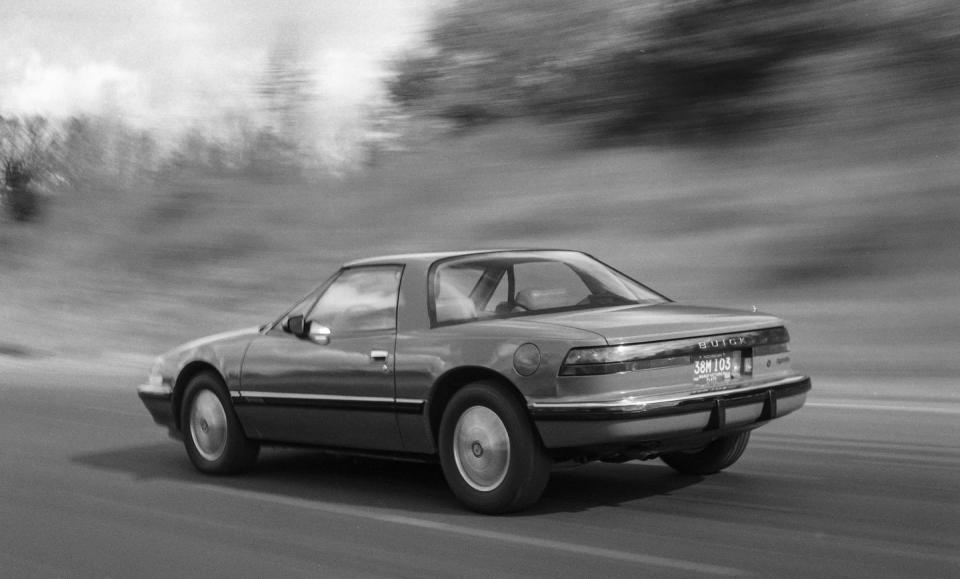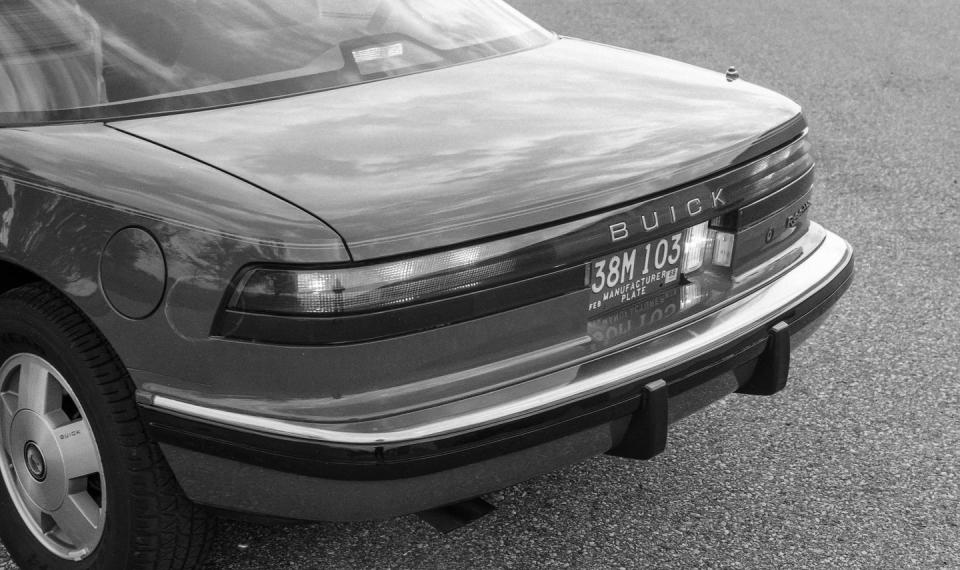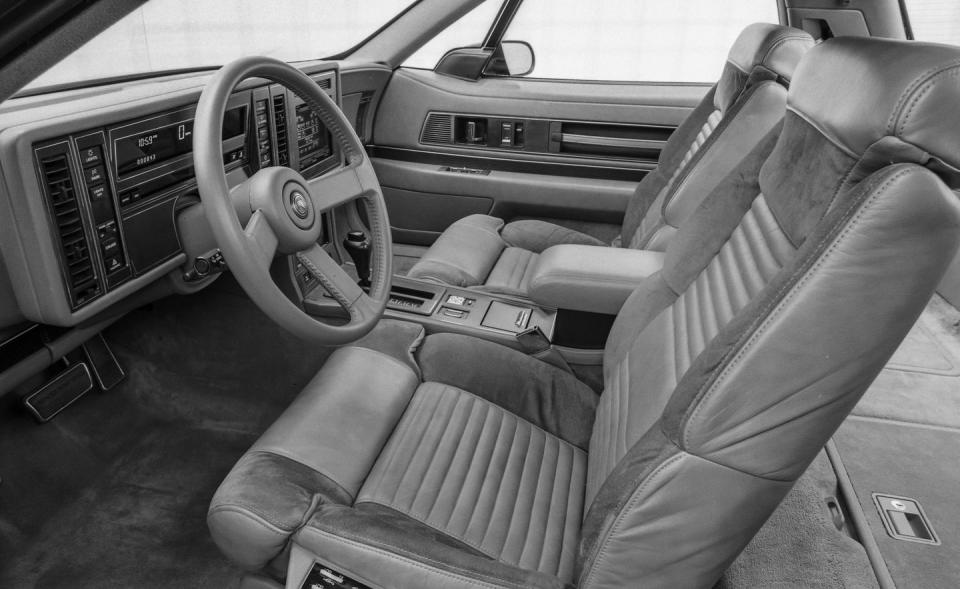Tested: 1988 Buick Reatta

From the February 1988 issue of Car and Driver.
Jay Qualman is a rare bird in the Detroit jungle: a purebred car cuckoo who nests in the high branches of the automobile business. Qualman's business card says he's the advertising manager for the Buick Motor Division, but never mind that. Sitting across his broad conference table from us, he wants to talk cars.
Qualman has the imposing stature of a retired NFL linebacker and the earnest face of an all-American kid grown up. He makes solid eye contact. He enjoys the give-and-take with hard-bitten magazine types like us. He begins by recalling his outlaw days of drag racing on Detroit's infamous Woodward Avenue, then expresses his more recent fondness for sports and GT cars of the serious stripe. He furrows his brow and tell us of his days in Buick product planning—he headed the department before moving to the advertising side last July—and of his ten-year battle to produce a two-seater. In the late seventies he was so close he could taste it. Then the Reatta came along. Keeping it alive required constant selling within the corporation, Qualman says, but now it's a reality.
The Reatta is Buick's all-new two-seater, and it's aimed squarely at—well, that's what we're here to find out. If "Buick'' and "sports car" sound like mutually exclusive terms, then you understand why we've come to Buick City in Flint, Michigan, to ask questions and kick tires.

We challenge Qualman by asking him what, precisely, the Reatta is doing in the 1988 Buick lineup. The division is supposedly retrenching to traditional family-car ground. Haven’t sticky tires and stoutly turbocharged engines been resigned to the dustbin? The cars Buick shows in its ads these days wear whitewalls and wire wheel covers, for crying out loud.
The Reatta, Qualman counters, is a good fit because it's not a pure sports car: it's a two-seater done the Buick way. He admits that he had to put his personal carguy preferences on hold to head the project. "We went to the market to ask people what kind of product they envisioned a two-seat Buick to be. We said to ourselves, 'Hey, if we're really going to be market-driven, we have to look at what they tell us.' They told us that what they wanted was an affordable Mercedes SL.

"The more we dug into it, the more we found that there was a group of buyers who wanted a kind of sporty orientation but still wanted a practical car—one, quite frankly, that a fairly well heeled guy could give his wife. The customers said, 'Give us comfort. Give u a car that's easy to get in and out of, that has a trunk.' " To this group, a smooth ride is as important as agility; quietness carries as much weight as performance. The car Buick wanted, Qualman says, would appeal to "people who really enjoy driving from point A to point B" when those two points are separated by hundreds of miles.
Qualman compares the Reatta to such luxury-prestige cars as the original Thunderbird, the aforementioned Merc, the Cadillac Allanté, and the Nissan 300ZX. These are two-seaters with the hard sports-car edges polished off and plenty of luxury gear pumped in. They deliver sports-car style without sports-car pain.
That's the why of the Reatta. The what is a bit simpler. The Reatta is offered only as a coupe; a convertible will come later, probably in the 1989 model year. It is of unit-body construction and is stamped from galvanized steel for rust protection. (The front fenders are injection-molded thermoplastic.) Like the Allanté, it's built on a shortened version of the Riviera/ Toronado/Eldorado/Seville chassis, but any other similarity to Cadillac's two-seater is pure coincidence. Qualman emphasizes that the two cars were developed independently and are different in critical dimensions.

Thanks to an all-new floorpan stamping, the Reatta's wheelbase is 9.5 inches shorter than the Riviera's, and its overall size, not surprisingly, is similar to the Mercedes-Benz 560SL's. The Reatta does share its chassis and driveline pieces with the Riv, however. In case you haven't crawled under a Riviera lately, come with us on a quick tour. The Reatta's suspension is fully independent, with struts all around, coil springs up front, a transverse plastic leaf spring in the rear, and anti-roll bars at both ends. Braking is handled by four-wheel discs with standard anti-lock control. Goodyear Eagle GT +4 all-weather performance radials, size 215/65R-15, hug the pavement. Underhood, it's one-size-fits-all: the only engine offered is GM's new 3.8-liter V-6, called the 3800, which is smoothed by a balance shaft and produces a respectable 165 hp at 4800 rpm. It powers the front wheels through a four-speed automatic transaxle.
Upon close examination, you'll find no new and exciting technological breakthroughs in the Reatta. Such recent developments as driver-adjustable shock absorbers, says Qualman, "are more for Chevy or Pontiac buyers. Buick buyers want their cars dialed in for them; they don't want to turn knobs." The engineers also wanted to avoid the quality headaches associated with introducing fresh hardware on a new limited-production car. (The goal is 15,000 Reattas a year.)

Now we're up to the how and the where of the development saga. When it came time to engineer the Reatta, Buick was plumb out of manpower: The division managed to get the exterior and interior styling done in-house, but it farmed out most of the engineering. Hawtal Whiting Design and Engineering, a British company that has worked for the Corvette group, performed all the necessary structural analyses. Buick sent Hawtal back to the computer repeatedly, until the Reatta's structure was more rigid than that of any other car it sells. Hawtal also engineered virtually all the bits and pieces of the Reatta that were not already in the Buick parts bins—from major body stampings to interior trim. Other British concerns were tapped for tooling and low-volume manufacturing expertise. Aston Martin Tickford helped out by building prototypes. Buick went to Japan, to the Ogihara Iron Works, for sheetmetal dies.
The new production equipment was installed in a renovated Oldsmobile axle-and-forge plant in Lansing, Michigan. Now dedicated solely to building Buick two-seaters, the plant was renamed the Reatta Craft Centre in recognition of the fact that it operates without a traditional assembly line. Instead, each car-in-progress is shuttled from one build station to the next by an automatically guided vehicle, and no car is released from a station until the workers there are satisfied that they have done their job right.

And what of the new breed coming out of the Craft Centre? After living with a pre-production Reatta for a week, we have much to report. We'll start with the styling: we think it's nice. We especially like the architecture you see in the rear three-quarter view. The Reatta isn't beautiful, but neither is it off-putting.
Inside, it's a different story. Slide behind the wheel and you'll swear you're sitting in a Riviera. The bad news is that you're confronted by a duplicate of the Riv's poorly designed instrument panel—right down to the touch-screen CRT. You may remember our complaints about this feature. Although Buick has fiddled with it a bit over the past year or so. the so-called Graphic Control Center still diverts the driver from his primary responsibilities: concentrating on the road and guiding the car. Its basic design still thwarts easy control of subsystems; you can't, for instance, adjust the climate control or the stereo when the engine gauges are on the screen.
Qualman looks away when asked if there was much in-house controversy about having the CRT in the Reatta. He admits that he would have preferred conventional gauges and controls as standard equipment, but the cost of retooling the dash and the cowl and reworking the wiring would have sunk the project.

The dashboard aside, the interior picture brightens considerably. Although the expensive, optional sixteen-way driver's seat (also Riv-derived) still needs improvement, the Reatta's two passengers enjoy sedan-style comfort. And aft of the seats, under the sloping rear window, is the kind of storage space you find in king-cab pickups. Add the good-size trunk and there is plenty of luggage room for those long point-A-to-point-B journeys.
Long trips in the Reatta should indeed be painless. It glides along the Interstates and keeps it composure on lumpy surface streets. The rigidity of its body is noteworthy. Push the Reatta to the limit in a corner and you'll find that its grip is good, too; we measured 0.79 g at the test track. Thanks to plenty of steadying understeer, even drivers of modest talent will find the Reatta difficult to upset in hard corners. The Reatta's drivetrain is as smooth and relaxed as any big Buick's. This car also moves along pretty well, posting a 0-to-60 time of 9.1 seconds and a top speed of 122 mph. Meanwhile, it keeps wind and mechanical noise commendably low. And, yes, the Reatta is easy to get in and out of.

As we rolled up the miles in comfort, however, it occurred to us that something—something important—was missing. Everything about the Reatta is, well, nice-very nice, really. All traces of sportscar crudity have been filtered out. But where is the greatness? We just can't find anything in the Reatta that makes the editorial heart race to the redline.
Somewhere along the way, while Buick was busily exorcising the sports-car demons from the Reatta, it also drove out the visceral excitement that we expect from two-place cars. Where is the sharp steering response that teases you, the taut suspension that goads you to take on a twisty two-lane, the power that opens your eyes wide and sends a thrill down your spine? Not here. The Reatta is nearly viceless, all right, but also nearly soulless.
Which brings us back to the who of the Reatta, and it isn't us. This car was designed not for enthusiasts—fringe radicals to Buick's way of thinking—but for people who can be satisfied by nice transportation. In other words, Mr. Qualman, you were right all along: the Reatta really does fit into the Buick lineup, just about perfectly.
A Buick is Born
The evolution of the rakish new Reatta.
For the Buick Reatta, the road to production has been an unusual one. General Motors' newest two-seater was born not in a regular product-planning workshop but in an advanced-design studio—an environment where automotive stylists are free from the constraints imposed on them when they're working on designs that are definitely scheduled for production.
Knowing that Buick was on the lookout for a new two-seat, sports-luxury design, David S. McIntosh, assistant chief designer in GM's Advanced Design Studio No. 2, penned a concept sketch for a bullet-shaped two-seater in early 1982. McIntosh says that at the time his design was not intended for any particular GM division; indeed, some of the earliest sketches for the new car wore Cadillac badges. When Cadillac opted for the Pininfarina-designed, two-seat Allanté, McIntosh's sleek design became a Buick exclusive.

The next issue to be resolved was body style: McIntosh's early sketches portrayed both convertibles and coupes. The matter was settled when the Allanté was approved by the GM brass, who felt that two new luxury roadsters would be one too many. Buick's convertible plans were put on hold.
The first scale model of Buick's proposed baby was completed in July 1982. A number of full-size clay models followed, and by January 1983 the exterior had been refined to a level that made it feasible for production. Says GM chief of design Chuck Jordan, "We had a lot of work to do to take the fat out [of the original design], but you can see that the evolution of the car is very clear: it never deviated from the smell of the original."
The Reatta program was approved for production in August 1984. A design engineer was assigned to the studio to help with the final stages of development, but throughout its evolution the Reatta's styling remained in the hands of the advanced-design team.
The result, says Jordan, is a car with "sporty elegance"—more like a Mercedes 560SL than a Corvette. But is the design too radical for the average Buick buyer? Jordan doesn't think so. After all, he says," 'Buick' does not mean 'stuffy.' " —Arthur St. Antoine
You Might Also Like

 Yahoo Movies
Yahoo Movies 
